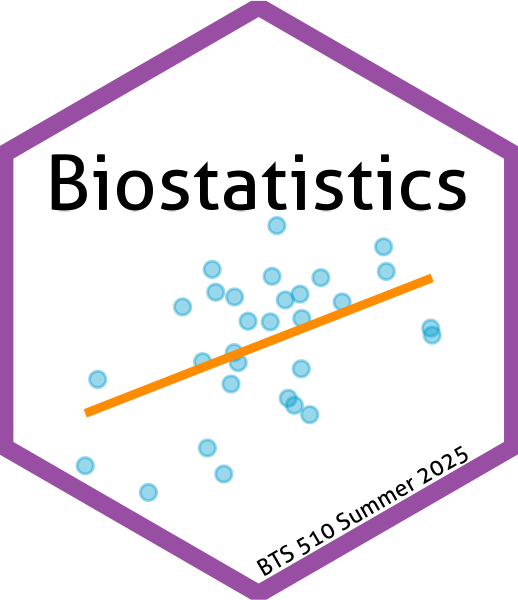Syllabus
BTS 510 Syllabus – Summer 2025
Intructor information
- Stefany Coxe, Ph.D.
- stefany.coxe@cshs.org
- Office hours: By appointment (send me an email to schedule)
- stefany.coxe@cshs.org
- Yujie Cui, M.S.
- yujie.cui@cshs.org
- Office hours: TBD
- Michael Luu, M.P.H.
- michael.luu@cshs.org
- Office hours: TBD
Course information
Learning goals
This course covers linear models (i.e., regression) with an emphasis on experimental studies. Topics include using and manipulating datasets, plotting data, estimation and uncertainty, linear regression, logistic regression, and Poisson regression.
Learning objectives
- Select the appropriate linear model for the research question
- Analyze data with the appropriate linear model
- Describe your findings for scientific and non-scientific audiences
- Create a written report of your findings
- Make conclusions about your research question(s) based on those results
Course structure
Time and location
We will meet in-person on Thursday from 9am to 10:30am in Picasso conference room in PDC.
Course format
This course takes place in a flipped, hybrid format. We will meet in person for 1 hour 30 minutes each week. This time will be spent on hands-on statistical programming in R. You will be responsible for completing course assignments such as videos and readings prior to class in order to be prepared to participate in the in-person meeting. You will also have assignments to complete after class.
Each week will follow a similar structure:
- Monday: Lecture videos posted
- Wednesday: Watch lecture and respond to survey by 8pm Wednesday
- Thursday: In-person meeting to review material and work on applications
- Sunday: Homework assignment due by end of day (midnight)
Software
We will be using R for this course. It’s ok if you don’t know how to use R (but also great if you do!). We’ll start from scratch in the first few weeks. I will provide information about the specific procedures you will need to know for this course.
- R is free and open source and works on any platform (Windows, Mac, Unix)
- Download R here
- I also recommend using Rstudio, which can be downloaded here
- If you use a Chromebook or tablet, you can use Rstudio via the cloud
- I have not used this much, so I don’t know all its shortcomings
- We’ll also be using Quarto
- Publishing system based on markdown
- Intersperse plain text and code
- Output to convenient formats, like HTML, PDF, Word
- Install Quarto
Assessments
Your work in this course will be assessed using a variety of methods.
Lecture videos (10%)
Watch the lecture video. Respond to the survey afterward with questions and comments.
Homework (60%)
There will be eight (8) five (5) homework assignments. The assignments generally involve running analyses in R, interpreting output, and presenting the results.
Final project (30%)
You will select a dataset, propose some research questions that can be answered using linear models, write up the results, and present your findings to the class. More details to follow throughout the semester.
Tentative schedule
Find the tentative schedule here.
Grades
| Grade | Percentage |
|---|---|
| A+ | >=97 |
| A | 93 - 96.99 |
| A- | 90 - 92.99 |
| B+ | 87 - 89.99 |
| B | 83 - 86.99 |
| B- | 80 - 82.99 |
| C+ | 77 - 79.99 |
| C | 70 - 76.99 |
| D+ | 65 - 69.99 |
| D | 60 - 64.99 |
| F | <= 59.99 |
Cedars-Sinai policies
Attendance
Attendance is not explicitly part of your grade in this course, but activities completed during the in-person portion of the course will be very helpful. If you need to miss class (such as for illness, religious event, professional activity, university-sanctioned event, or any other reason), please contact me to make any necessary arrangements.
Academic dishonesty and misconduct
Please refer to your policy handbook for a description of what constitutes academic dishonesty.
- While you may work with other students on your homework assignments, I expect all students to complete and turn in their own work.
